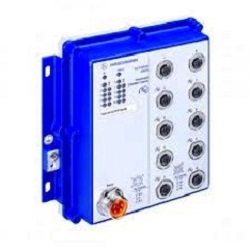Wall Mounted Switches
Octopus Family of Switches

The switches in the OCTOPUS family can be used to set up cost-effective connections to Ethernet terminal devices under the harshest conditions. PoE versions can power terminal devices operating in the most challenging environments directly via the Ethernet cable, doing away with the need for additional power supply units.
The Octopus family offers the complete solution for extreme environmental condition. When space is limited and applications demand rugged solutions, OCTOPUS switches are the ultimate option. Wherever reliable, intelligent and efficient data transmission has to be guaranteed under extreme conditions, the OCTOPUS family is more than suitable. Not only at the device level, in factory and process automation, but also in trains (EN 50155) or on board ships (GL) – in environments where it needs to withstand great mechanical stress, vibrations, wet conditions, dirt or dust. These switches are the most robust switches currently on the market and they meet all appropriate industry standards. With Power over Ethernet, Hirschmann has combined its IP67 solutions with a totally future-proof technology. This is deployed in all situations where new applications and end devices such as IP cameras or IP telephones require electrical power without additional installation work. Due to their compact structure all products in the OCTOPUS family can be mounted on the wall or directly on the machine. The IP67 waterproof variants of the proven managed Hirschmann switches offer 5/8/10/16/24 Twisted Pair ports (each with up to 8 PoE ports), using ODVA-standardised 4-pin M12 technology. These switches can be cascaded freely, making it straight forward to build decentralised structured networks with the shortest possible patch cable to the end devices. Both the 16- and 24-port versions are also available with two 100BASE-FX uplink ports (microFX). Since the switches can be cascaded according to your requirements, networks with a distributed structure and short transmission distances to the terminating equipment can be implemented.
Product Features
IP67/IP54 metal housing - Specially designed for use at the field level with automation networks, the switches in the OCTOPUS family allow for the highest industrial protection ratings (IP67/IP54) regarding mechanical stress, humidity, dirt, dust, shock and vibrations. They are also able to withstand heat and cold, while fulfilling the strictest fire prevention requirements.
Unmanaged, Basic-managed and Professional-managed versions - The OCTOPUS family includes switches with 5 up to 28 ports. Gigabit versions are also available which, just like the Fast Ethernet models, feature vibration-resistant M12 connectors for twisted pair cables or fibre-optic ports according to IEC 63076-3-106 v1/v4. For managed models, full-featured Industrial HiVision Management Software is available.
Configurable - The online configurator allows rapid selection of the switch that best suits your individual application. Over 100 different designs offer an optimum solution for a range of application scenarios and provide maximum flexibility.
Protocol Support - Models now available that support Profinet, Ethernet/IP and Modbus TCP
Construction - The rugged design of the OCTOPUS switches are perfect for installing directly on machinery, outside of control cabinets and distribution boxes. The switches can be cascaded as often as required – permitting implementation of decentralized networks with short paths to the respective devices to considerably reducing costs for cabling.
Supported Software – Classic Software Levels – Layer 2 Professional (L2P)
HiOS Software Levels – Layer 2 Standard (L2S) Layer 2 Advanced (L2A) or Layer 3 Standard (L3S)
Standard features include:
- Totally enclosed IP67 design
- ODVA-standardised 4-pin M12 D-code IP67 Ethernet connector
- Fibre optic Gigabit Backbone to the field level
- Management via SNMP v1, v2, v3, web GUI or TELNET
- Redundancy via HIPER-Ring and Rapid Spanning Tree
- Redundant power supply for availability
- Operating temperatures as low as -40°C up to +70°C
- External signalling of alarms via signal contact or networking messaging


